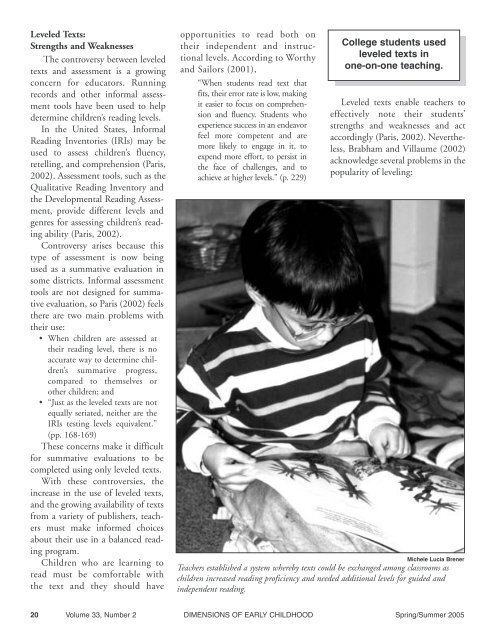Social Stories - Southern Early Childhood Association
Social Stories - Southern Early Childhood Association
Social Stories - Southern Early Childhood Association
You also want an ePaper? Increase the reach of your titles
YUMPU automatically turns print PDFs into web optimized ePapers that Google loves.
Leveled Texts:<br />
Strengths and Weaknesses<br />
The controversy between leveled<br />
texts and assessment is a growing<br />
concern for educators. Running<br />
records and other informal assessment<br />
tools have been used to help<br />
determine children’s reading levels.<br />
In the United States, Informal<br />
Reading Inventories (IRIs) may be<br />
used to assess children’s fluency,<br />
retelling, and comprehension (Paris,<br />
2002). Assessment tools, such as the<br />
Qualitative Reading Inventory and<br />
the Developmental Reading Assessment,<br />
provide different levels and<br />
genres for assessing children’s reading<br />
ability (Paris, 2002).<br />
Controversy arises because this<br />
type of assessment is now being<br />
used as a summative evaluation in<br />
some districts. Informal assessment<br />
tools are not designed for summative<br />
evaluation, so Paris (2002) feels<br />
there are two main problems with<br />
their use:<br />
• When children are assessed at<br />
their reading level, there is no<br />
accurate way to determine children’s<br />
summative progress,<br />
compared to themselves or<br />
other children; and<br />
• “Just as the leveled texts are not<br />
equally seriated, neither are the<br />
IRIs testing levels equivalent.”<br />
(pp. 168-169)<br />
These concerns make it difficult<br />
for summative evaluations to be<br />
completed using only leveled texts.<br />
With these controversies, the<br />
increase in the use of leveled texts,<br />
and the growing availability of texts<br />
from a variety of publishers, teachers<br />
must make informed choices<br />
about their use in a balanced reading<br />
program.<br />
Children who are learning to<br />
read must be comfortable with<br />
the text and they should have<br />
opportunities to read both on<br />
their independent and instructional<br />
levels. According to Worthy<br />
and Sailors (2001),<br />
“When students read text that<br />
fits, their error rate is low, making<br />
it easier to focus on comprehension<br />
and fluency. Students who<br />
experience success in an endeavor<br />
feel more competent and are<br />
more likely to engage in it, to<br />
expend more effort, to persist in<br />
the face of challenges, and to<br />
achieve at higher levels.” (p. 229)<br />
College students used<br />
leveled texts in<br />
one-on-one teaching.<br />
Leveled texts enable teachers to<br />
effectively note their students’<br />
strengths and weaknesses and act<br />
accordingly (Paris, 2002). Nevertheless,<br />
Brabham and Villaume (2002)<br />
acknowledge several problems in the<br />
popularity of leveling:<br />
Michele Lucia Brener<br />
Teachers established a system whereby texts could be exchanged among classrooms as<br />
children increased reading proficiency and needed additional levels for guided and<br />
independent reading.<br />
20 Volume 33, Number 2 DIMENSIONS OF EARLY CHILDHOOD Spring/Summer 2005
















